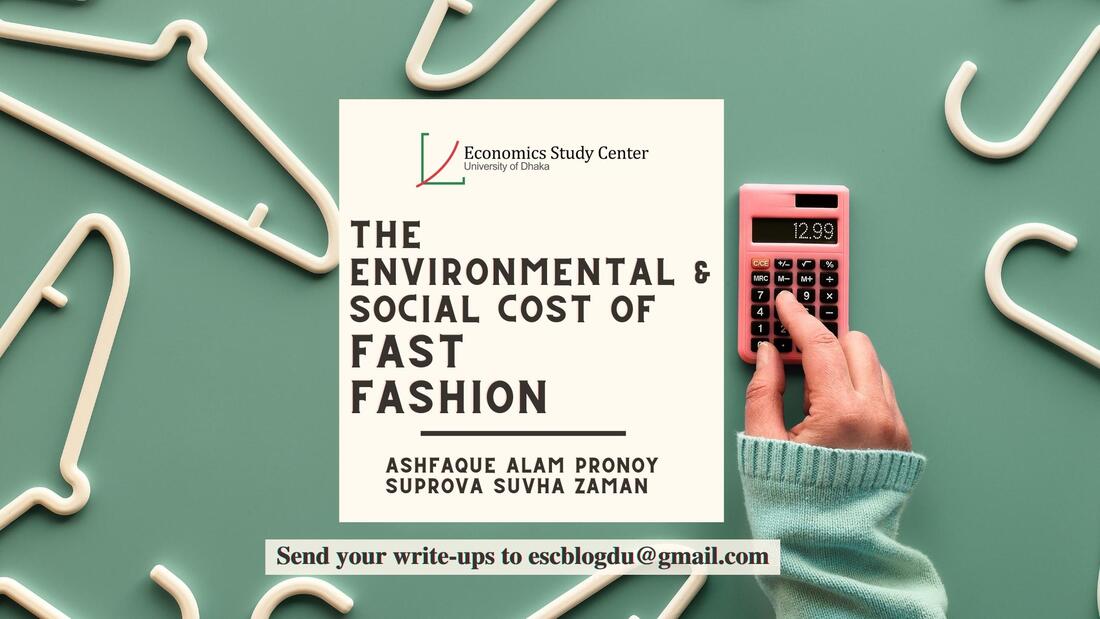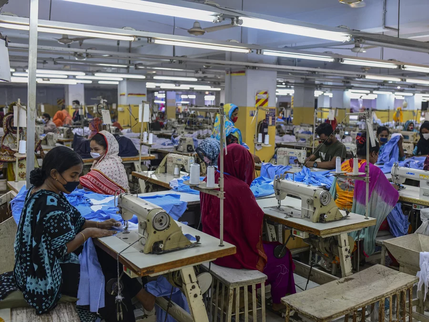ECONOMICS STUDY CENTER, UNIVERSITY OF DHAKA
|
Ashfaque Alam Pronoy, Suprova Suvha Zaman Design: Farha Tasneem The term "fast fashion" is used to define a particular brand of fashion where high-fashion and trendy fashion clothes are produced on a mass scale at a low cost to guarantee a profitable and exploitative business model. Fast fashion is quite a recent thing. It was first introduced by the fashion brand Zara in New York at the beginning of the 1990s. It was a new thing for consumers at the time to get trendy and high-fashion clothes at a low cost. It was revolutionary because people could really wear a piece of clothing a few times before discarding it. Everyone could now afford to dress like their favorite celebrities or wear the latest trends. It reached a new height with the help of industries that specialize in manufacturing low-cost clothes. Most of these garments factories are situated in Southeast Asia. How Fast Fashion is Expensive for Us and Our Planet: The products of fast fashion are intentionally made cheaper and not durable. To keep the cost to a minimum, the brands rely on unsustainable fabrics, which are made from synthetic fibers. Again, these fibers are non-renewable and are made using fossil energies. Each time, an estimated 342 million barrels of oil are used. It might seem surprising, but textile production contributes more to climate change than aviation and shipping combined. The industry is responsible for 8–10% of carbon emissions, as the data shows. From sourcing to disposal, pollution is present in each step. Again, the fast fashion industry doesn't only produce cheap clothes; it also influences the consumer's demand for buying clothes. In this era of social media, the trends are changing rapidly. Due to this fast change in trends, the demand for new designs is also increasing. Clothing is being produced at an increasing rate by businesses to keep up, which suggests that the designs have not been stress-tested and are composed of less expensive materials. As a result, they don’t last long, or even if they do, the trend changes, and the clothes are thrown away. A study shows that in pre-production, 15 percent of the fabric used in garment manufacturing is wasted. In post-production, 60 of 150 million (approximately) garments produced in 2012 were discarded. Besides, from 1975 to 2018, the global per capita product of cloth increased from 5.9 kg per time unit to 13kg per time unit. All of this indicates a high rate of cloth waste. Though the cloth waste rate is high, cloth recycling hasn’t increased much. This is creating potential harm to public health and the environment as the waste can produce methane when it is burnt. Methane is a greenhouse gas that is 28% more potent than carbon dioxide. This is severely impacting global warming. Social Impact of Fast Fashion: The fast fashion industry is accused of exploitation of workers. Women in developing countries are the prime victims of it. The industry’s production vastly relies on female workers from developing countries. Of about 74 million textile workers globally, 80% are women of color. These women are often paid less, and they're forced to work long shifts. Female workers in Bangladesh earn the monthly equivalent of £45. Violations of human rights are also a common phenomenon here. In the Rana Plaza tragedy in 2013, 1129 deaths occurred, among whom 80% were women. Women are often faced with verbal and physical abuse in factories. The factory owners take advantage of their social status. Sexual abuse of female workers is also common here. In the fast fashion industry, many brands promote feminist slogans on their clothes, but the clothes are made by underpaid female workers in developing countries. This industry severely disempowers women. The use of harmful chemicals in producing clothes also affects the health of the workers. (Bick, Halsey, and Ekenga, 2018) Workplace conditions have long put workers in the supply chain at risk of disease, cancer, damage to their endocrine systems, problems with reproduction, injuries, and even death. Why Do We Need A Sustainable Approach to Fashion: The global population is consuming way more clothes than they need. According to the American Chemical Society, since the 2000s, fashion production has doubled, and it will likely triple by 2030. This will lead to more pollution if we don't have a sustainable approach to fashion. Many sustainable fashion experts claim that the term "Sustainable Fashion" is all-inclusive, encompassing processes, products, activities, and actors (policymakers, brands, consumers) working toward a carbon-neutral fashion industry based on ecological integrity, social justice, equality, and animal welfare. A sustainable approach to fashion or sustainable fashion is necessary to solve many problems. A huge amount of textile waste is being created by fast fashion brands because of their weekly new launches of fashion trends. In comparison to that, a sustainable brand doesn’t produce clothes rapidly; rather they focus on producing long-lasting clothes. Having a sustainable approach to fashion will help us not to follow fashion trends blindly and to invest in long-lasting clothes. This will help to reduce the amount of waste produced by the fashion industry. The fast fashion industry is also known for the exploitation of workers. Most of the fast fashion brands' production is done in developing countries where they can find labor for cheap wages. These fast fashion garments present a harsh, inhumane workplace environment for the workers. Moreover, there is no transparency in the conditions here. Workers often face poor safety and health conditions. There are also allegations of using child labor by fast fashion brands. We need a sustainable approach to fashion to protect our environment and to stop worker exploitation by the brands. Polyester, Cotton and the Impact of Fibers on Climate Change: The majority of these fast fashion items are made of fibers, cotton, and polyester-based materials. And the effects of these materials on climate change are extremely detrimental. Pesticides and herbicides are overused in the production of fiber, which causes them to contaminate the soil. In naturally existing ecosystems, fertility and biodiversity are decreased by pesticides and herbicides. Additionally, a number of harmful chemicals are used in the spinning, weaving, and other textile operations, which release them back into the environment. According to Forbes, the most widely used fiber in the textile business, polyester fiber, uses over 70 million barrels of crude oil each year. These synthetic fibers are the primary cause of the significant increase in microplastics, which break down slowly in the oceans. On the other hand, cotton farming uses a lot of water—roughly 250 billion tons per year. A single cotton shirt takes 2,700 liters of water to produce, which is enough water for one person to drink daily for two and a half years. How Can the Impact of Fast Fashion be Reduced: To reduce the impact of fast fashion, our overconsumption needs to stop. Many sustainable and slow fashion brands are now emerging, but few people are willing to purchase from them. A survey conducted by the London Fashion Retail Academy showed that a third of young people wouldn’t pay more than £5 extra for sustainable garments. Recycling our clothes is another way to reduce the impact of fast fashion. Buying second-hand clothes can also help. Even renting our clothes will help us stop buying more and more clothes. But the most important thing to do here is to buy fewer clothes. It is the simplest yet, but the most effective one. Big Brands and the "Fashion Industry Charter for Climate Action" : With the goal of achieving net-zero emissions by 2050, the fashion stakeholders established the "Fashion Industry Charter for Climate Action" in 2018 under the auspices of UN Climate Change. At COP26 in 2021, the Fashion Industry Charter was reaffirmed after being introduced at COP24. In order to limit global warming below 1.5 degrees, it aims to get the fashion industry to net-zero greenhouse gas emissions by 2050. The fashion sector is responsible for 20% of the world's wastewater and over 10% of the carbon emissions. The charter attempts to lessen the industry's contribution to climate change. Slowly Leaning in to Slow Fashion from Fast Fashion: Slow fashion, a movement that supports moral and sustainable production practices to safeguard people and the environment, is the antithesis of fast fashion. The world must make the switch to employing more slow-fashion and sustainable clothing items in order to lessen the harmful effects of fast fashion. Using slow fashion offers many advantages, including a longer lifespan, sustainability and environmental friendliness, and most significantly, ethical and just manufacturing. We require a model that is regenerative by design and provides higher resource productivity in order to shift from rapid fashion to slow fashion. The fast-fashion sector uses a lot of resources. Therefore, we can mix non-renewable resources with recycled feedstock and use fashion waste as a circular material to reduce resource consumption. Fast-fashion businesses can decrease waste and energy use and shift to efficient production by utilizing innovative and innovative technologies. For instance, the multinational company of fast-fashion retail clothing, H& M, is putting money into digital waterless dyeing. Customers can also choose slow fashion because it is more durable and good for the environment. There are a few other things consumers can do, like decluttering, reselling, or donating. Consumers can also investigate before buying any stuff, because we consumers need to ask ourselves if we really need these things for practical purposes. Reference:
1 Comment
10/20/2023 09:28:17 am
Great blog post! I found it to be informative and well-written. It's always a pleasure to stumble upon content that offers valuable insights and engages the reader. Keep up the good work, and I look forward to reading more from your blog in the future!
Reply
Leave a Reply. |
Send your articles to: |







